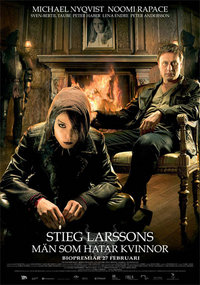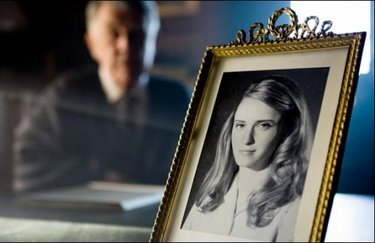(The following review contains descriptions of adult scenes and themes. Proceed accordingly.)
The original title of Steig Larson’s novel, in Swedish, literally translates to The Men Who Hate Women. And, for the movie version, director Niels Arden Oplev seems to have taken this to heart with a vengeance.
I, like seemingly every other subway passenger in New York, have read the original novel. I liked but didn’t love it, and have every intention of eventually reading the other two in the series. For me, the novel started slow, but evolved into an enjoyable but unremarkable page-turner.
The movie, however, left a bad taste in my mouth, for several reasons. Some are personal, some are cinematic, but the biggest one is rather glaring.
In the book, we see many things in Lisbeth Salander’s life before she joins Mikael Blomkvist on his search for Harriet Vanger’s killer. We learn about her group of semi-friends, and her friendship of a sort with her boss (despite his unrequited affection for her). We see her as a hacker, we learn a bit about where she comes from, and, as one component among many, we’re treated to a rather horrible series of incidents with her legal guardian, once her prior guardian (for whom she held real affection) suffered a stroke.
In the movie, we see Salander first when Nils Bjurman comes to collect surveillance on Blomkvist, and then rather briefly. The large bulk of the rest of her screen time between this and joining the main plot is spent watching her a) be assaulted in the subway, managing to drive off her attackers but suffering the loss of her laptop, b) get raped, twice, the second time very graphically, and c) exact torture and revenge on the rapist.
In the book, these incidents happen, but they’re part of a larger pattern of illuminating Salander as a character. In this sort of film, you don’t have the time (or you shouldn’t) to linger slowly on things that have no direct relation to the plot. I realize that it does tie to larger themes in the movie, but the way it’s handled feels almost fetishistic.
Additionally, the differences between media work to the film’s disadvantage here. In the book, you share the scene from Lisbeth’s point of view. It’s brutal, and horrifying, and though I didn’t care for the use of rape to build sympathy for a character, it did its job. Film doesn’t allow you that pass into one character’s head. Instead, there’s an element of voyeurism at work that you can’t escape. Throughout, this film loves tight closeups, and it gives you no option to look away or to process the horror yourself. It shows everything, in excruciating detail, and the sheer amount of screen time spent on the subplot is ridiculous for its ultimate significance, or lack thereof.
Even beyond the viewer-as-accomplice feel of the first third of the movie, the film had some problems. Michael Nyqvist, as Blomkvist, was competent but unremarkable. Noomi Rapace, who played Salandar, did a fine job with a difficult character. (I don’t know if I’ll see the film, but I will be interested to hear who gets cast as Salandar opposite Daniel Craig’s Blomkvist in the American remake.) But I felt little connection with either character, nor did I observe much connection between them.
The cinematography is of a piece with the rest of the film, in many ways. The colors are washed out, muted, to begin with, and get slowly more vibrant as the action progresses, though they never become truly vivid. The lighting is harsh and intense or brutally dark, with very little in between.
The title sequence sets the movie’s dark, muted palate.
Were the movie paced a bit more quickly, or perhaps if I didn’t already know the answer to “whodunit,” I could have enjoyed the film more: the best moments tended to be the ones of revelation or suspense, but these were few and spaced between long, slow stretches. (I cannot tell you how many times we watch a bar load on a Mac in this movie, or lines of code flash by. Watching other people compute is never exciting, hacking or not.) I realize the book is long and complex, but so much was already cut (including Blomkvist’s relationships with pretty much anyone besides Salandar) that they should have gone the distance and narrowed the focus to just the Harriet Vanger case and anything related to it.
There were some strong choices. The use of Harriet’s photo was clever and memorable, and an excellent use of the visual nature of film.
Her face comes to haunt the viewer, much as it seems to haunt both her uncle and, eventually, Blomkvist. The climactic scene in a basement room is tense and well-played, if skirting a bit toward the torture porn the movie seems to favor.
On the whole, however, the movie plays like an episode of Criminal Minds that’s been stretched to encompass two and a half hours. 90 minutes would have been plenty for the good parts. This isn’t Schindler’s List, after all, it’s a popular crime novel. And where the book is atmospheric, the film just gets mired. It has its moments, but on the whole, it takes itself too seriously and plays its hand too hard.
Rating: C It has some merits, and it’s not a horrible film. But for me, what I didn’t like roundly distracted me from what I did.





